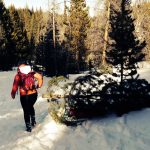
A tradition since the 16th century, decorating a Christmas tree is a time-tested custom for families celebrating the season. Our family holiday kicks off in early December when we head to a national forest to cut down our yearly Christmas tree. While some may think that cutting down a tree in a forest isn’t a way of leaving no trace, according to the U.S. Forest Service, it actually helps the forest. It’s a tool to help manage and conserve the forest and also provides holiday trees to families. Here are seven tips for your first tree-cutting experience.

Obtain A Permit
To cut down a tree in a national forest, you must obtain a permit. Permit sales begin in October for many locations and may sell out quickly based on location. Weekend permits are the quickest to be scooped up, so consider a weekday for more flexibility. There are 155 national forest service areas covering more than 200 million acres in the United States. To see whether your local national forest location allows tree cutting, head to https://www.fs.fed.us/. Next, select your region and the forest near you. Once the page specific to the forest loads, click the Passes & Permits section. The Forest Products Permits section should provide you Christmas tree cutting info specific to the area you’ve chosen.
Some locations sell permits on-site the day of or at the local National Forest Service ranger district offices. However, many locations only sell permits online. Head to recreation.gov to secure a permit online. Cost ranges from $10 to $25 per tree, typically based on location, with a general limit of five permits.

Know The Rules
Certain locations may have specific rules, so be sure to familiarize yourself before heading out to find the perfect tree. Rules will include the times that cutting areas are open, restricted areas and more. Here are some of the most common rules.
- Do not cut a tall tree just for the top.
- Select a tree that is 6 inches or less in diameter at the trunk.
- Cut the tree no more than 6 inches above ground level.
- The tree must be 200 feet from recreation sites, campgrounds and roads.
- Do not select trees that are on or near the banks of rivers, lakes, streams or other wet areas.
- Place your tree tag around your tree and be ready to show your tag when exiting the cutting area.
After you obtain your permit, head to the Know Before You Go page from the U.S. Forest Service before you leave on your tree-finding adventure. Your permit tag will also have instructions on it for a safe trip to the forest.

Pack The Proper Supplies
Don’t pull a Clark Griswold and forget to bring a saw. To have a successful hunt, be sure to pack what you need for your adventure. Don’t forget supplies to get your tree home safely. Throw in items like a tarp and rope for tying your tree down to the roof of your vehicle.
Be sure to check the weather and ground conditions before you head out. We’ve had beautiful days with dry conditions, and we have also traipsed through snow. Plan for the hunt to take longer than you expect. Layers, gloves, boots (maybe ice cleats or snowshoes) — you will want it all. If you have little ones, a sled is a great idea for pulling them along. Consider a sled, too, for pulling your tree back to the car.

Play It Safe
Be prepared for winter weather conditions. Have proper tires for snowy conditions. Make sure to have a full tank of gas when you leave. Pack extra clothing, water, blankets and food in the car in case the unexpected happens. You may not have cell reception, so don’t rely on it for directions or if there happens to be an emergency. Plan ahead time-wise to be sure you aren’t still out searching for a tree after dark. Be sure to let someone know where you are headed.

Make It A Day
Bring the chairs, portable firepit and hot chocolate to make a day of it. Pack lunch or an early dinner and enjoy it before or after you find your tree. If allowed, bring the pups along to enjoy a day amongst the trees. On weekends, Smokey Bear or even Santa Claus may be at certain locations for a holiday visit.

Think Charlie Brown, Not Rockefeller
Part of the magic of cutting down your own Christmas tree growing in the wild is the uniqueness of what you find. Don’t expect your tree to be full and perfectly even. But, that is what makes your tree even more special. You aren’t picking a farm tree that is given the perfect ratio of water, nutrients and sunlight. Your tree is a fighter, adapting to life in the forest. Don’t look for the “perfect tree” — look for the tree that is perfect for your family. Search high and search low, and enjoy the quest of finding what Clark Griswold refers to as “that most important of Christmas symbols.”

Decorate And Enjoy
Take advantage of the uneven branches and bare spots when you decorate your one-of-a-kind Christmas tree. Be sure to water it just like any real tree, and enjoy your tree throughout the season. Find a farm to donate the tree to at the end of the season for animals to enjoy, or find a tree recycling program near you. We just love knowing that our tree from year to year is being used as mulch at the local parks.





